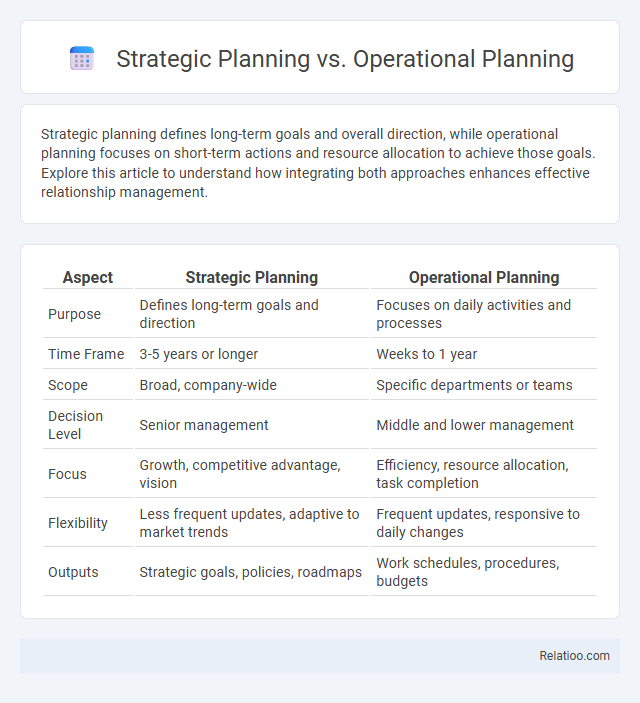Strategic planning defines long-term goals and overall direction, while operational planning focuses on short-term actions and resource allocation to achieve those goals. Explore this article to understand how integrating both approaches enhances effective relationship management.
Table of Comparison
| Aspect | Strategic Planning | Operational Planning |
|---|---|---|
| Purpose | Defines long-term goals and direction | Focuses on daily activities and processes |
| Time Frame | 3-5 years or longer | Weeks to 1 year |
| Scope | Broad, company-wide | Specific departments or teams |
| Decision Level | Senior management | Middle and lower management |
| Focus | Growth, competitive advantage, vision | Efficiency, resource allocation, task completion |
| Flexibility | Less frequent updates, adaptive to market trends | Frequent updates, responsive to daily changes |
| Outputs | Strategic goals, policies, roadmaps | Work schedules, procedures, budgets |
Introduction to Strategic and Operational Planning
Strategic planning involves defining Your organization's long-term vision, goals, and the overall direction to achieve sustainable growth. Operational planning translates strategic objectives into detailed, actionable tasks, focusing on day-to-day processes and resource allocation. Understanding the distinction between strategic and operational planning is essential for aligning high-level strategies with practical execution.
Defining Strategic Planning
Strategic planning is the process of defining an organization's long-term vision, goals, and priorities, which guides decision-making and resource allocation to achieve sustainable competitive advantage. It sets the overarching framework distinguishing it from operational planning, which focuses on day-to-day activities and short-term objectives necessary to implement the strategic plan. Strategy encompasses the comprehensive plan of action designed to achieve the strategic goals, acting as the bridge between strategic planning and operational execution.
Defining Operational Planning
Operational planning focuses on defining specific, short-term actions and resource allocations needed to achieve the objectives outlined in the strategic plan. It translates broad strategic goals into detailed tasks, schedules, and performance metrics to guide daily business operations. Unlike strategic planning, which sets long-term vision and priorities, operational planning emphasizes execution, efficiency, and immediate results within departments or teams.
Key Differences Between Strategic and Operational Planning
Strategic planning involves setting long-term goals and determining the overall direction to achieve your organization's vision, while operational planning focuses on short-term actions and day-to-day processes needed to execute the strategy effectively. The key differences include scope, with strategic planning addressing broad objectives and resource allocation, and operational planning concentrating on specific tasks, timelines, and performance metrics. Understanding these distinctions ensures better alignment between your strategy and operations, driving sustainable success.
Objectives of Strategic Planning
Strategic planning focuses on setting long-term objectives that define an organization's overall direction and competitive positioning, distinguishing it from operational planning which concentrates on short-term, day-to-day activities. Objectives of strategic planning include identifying growth opportunities, allocating resources effectively, and establishing measurable goals that align with the company's vision and mission. Strategy encompasses the broader framework that guides both strategic and operational planning to achieve sustained competitive advantage in the market.
Objectives of Operational Planning
Operational planning targets specific, short-term objectives that directly support broader strategic goals, ensuring efficient resource allocation and task management. Your focus during operational planning should be on day-to-day activities that optimize workflow, improve productivity, and meet key performance indicators. This hands-on approach translates strategic visions into actionable steps with measurable outcomes, aligning team efforts toward organizational success.
Time Frames: Long-Term vs Short-Term Focus
Strategic planning centers on long-term goals typically spanning three to five years, guiding an organization's overall direction and vision. Operational planning focuses on short-term objectives, often detailed monthly or quarterly, ensuring day-to-day activities align with strategic goals. Strategy encompasses both time frames by integrating long-term ambitions with actionable short-term plans to achieve sustainable success.
Roles and Responsibilities in Each Planning Process
Strategic planning defines Your organization's long-term goals and establishes the vision, with executives and senior leaders responsible for setting priorities and allocating resources. Operational planning translates strategic goals into actionable tasks, where middle managers and team leaders oversee day-to-day activities and ensure alignment with broader objectives. Strategy acts as the overarching framework guiding both strategic and operational planning, requiring collaboration between leadership and departments to maintain focus and adaptability.
Integrating Strategic and Operational Plans
Integrating strategic and operational plans ensures that long-term organizational goals align with day-to-day activities, creating a cohesive roadmap for success. Strategic planning defines the overarching vision and objectives, while operational planning translates these goals into actionable steps, timelines, and resource allocations. Effective integration enables organizations to adapt swiftly to market changes, optimize performance, and achieve sustainable competitive advantage.
Conclusion: Choosing the Right Planning Approach
Choosing the right planning approach depends on Your organization's goals and timeframes, with strategic planning focusing on long-term vision and overall direction, operational planning addressing day-to-day activities and resource allocation, and strategy serving as the comprehensive roadmap aligning both. Effective integration of these methods ensures cohesive execution and adaptability in a competitive market. Prioritizing clarity in each planning phase enhances decision-making and drives sustainable growth.

Infographic: Strategic Planning vs Operational Planning
 relatioo.com
relatioo.com